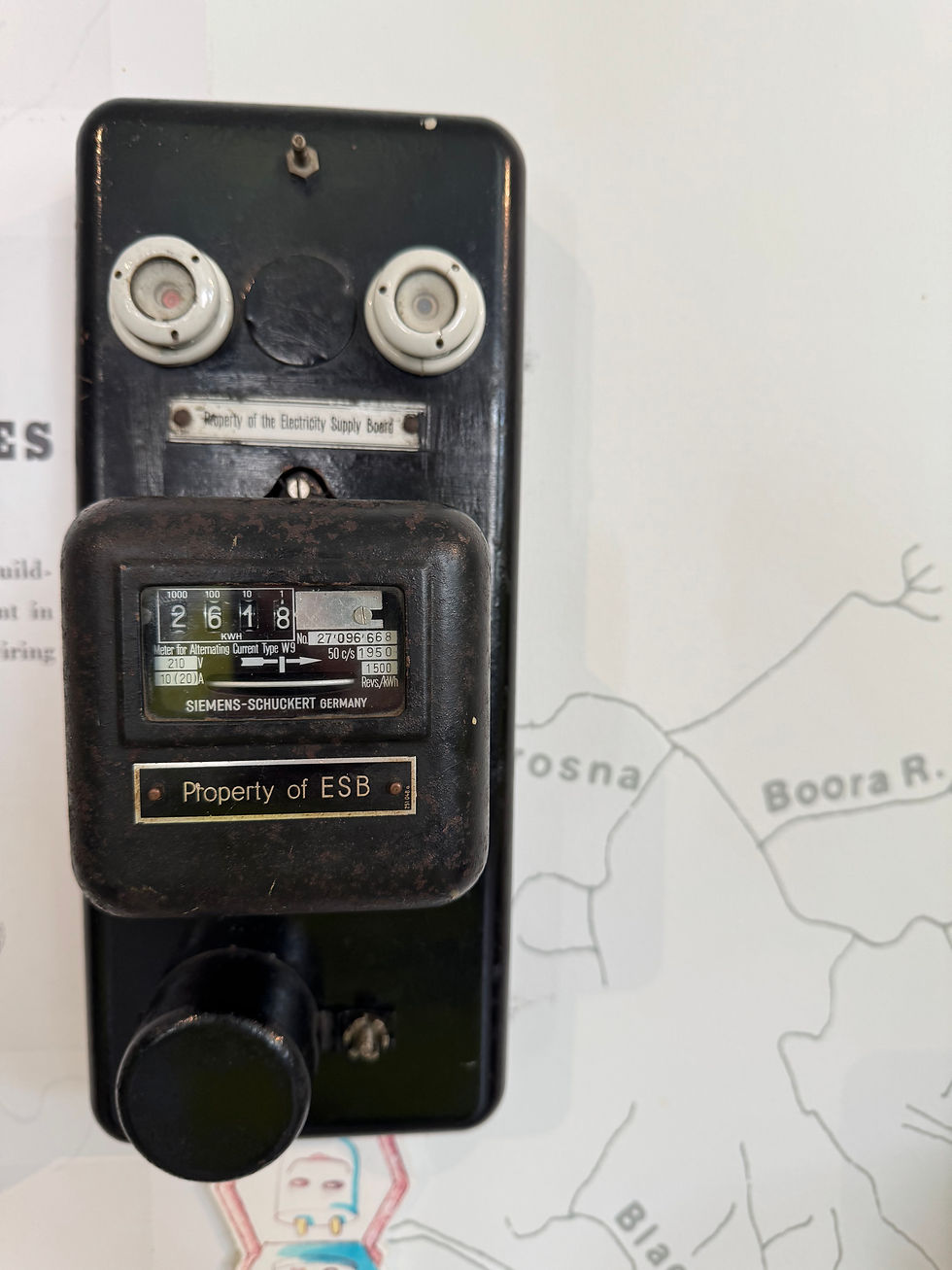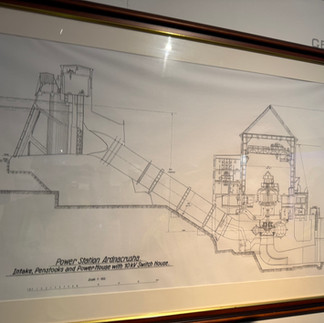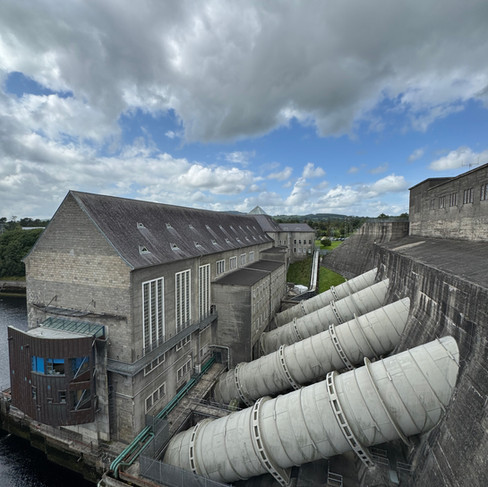Power of Ardnacrusha
- Olha Pavlovska
- Aug 9
- 5 min read
Ardnacrusha Power Station is the central object and the main achievement of the Shannon Hydroelectric scheme, a large project for the practical usage of the moving water power of the Shannon River, the largest on the island of Ireland and the British Isles.

The project was developed in the 1920s, at the dawn of independent Ireland, by a young engineer named Thomas McLaughlin (he also became the first director). Construction of the station began in 1925 (exactly one hundred years ago) and was completed in 1929. Five thousand people were involved in the construction, of which 4,000 were Irish and 1,000 were specialists from Germany, who were engaged in the implementation of the technology.
The design was carried out by the German company Siemens-Schuckert. The scheme involved the construction of a separate channel, which eliminated the need to change the river bed or build a reservoir.
At the southern end of Lough Derg, the so-called parteen weir was built - a system of locks that divided the water flows into two parts. In one direction went the good old Shannon riverbed, picturesque but not full-flowing enough for use at the station, and in the other - a newly built canal.

The project cost the young State 1/5 of the budget - an insane amount of money, which today no one would agree to. But at that time in Ireland, only one in three houses was electrified, and the country needed new modern solutions. The launched station made it possible to power almost the entire country at once, and bring not only electricity to homes but also give households access to running water for daily needs.
Today, the station supplies energy to only 1% of consumers - about 40,000 households in different parts of the country (Limerick, Clare, West Cork and even Dublin)

The station territory is visitor-friendly, although it is an operating enterprise. Groups of people are accompanied by two guides - students from local colleges - and they share interesting facts about the station.
One of the old Parsons turbines was turned into a fountain for the 75th anniversary of its opening. And the old ceramic insulators now serve as flower beds :)
The banks of the new canal are rented out to farmers and are grazed by sheep and cows.
How does it work?
People have learned to use the power of water for their needs since ancient times - from mill wheels to modern turbines.
The Ardnacrusha station was built 9 miles downstream from Parteen Weir, and blocked the mouth of the new canal with a giant gate. The difference in water levels is 100 feet (about 30 meters)
To increase the flow of water entering the turbines, four huge pipes (penstocks) were built, each capable of passing 100 tons of water per second. Water supplied through the pipes moves the turbine mechanism, generating electricity.
The penstocks have remained unchanged since the day the station was put into operation. Every joint, every rivet, every screw is the result of hundreds of hours of work by Irish builders 100 years ago. The only change the pipes underwent was scraping off a thick layer of black tar, which turned out to be a bad decision and led to excessive heating of the water on sunny days (yes, there are some like that in Ireland, too).
To prevent debris and rubbish from getting into the turbines, a fine grate was installed in front of the pipe openings, which holds back everything that floats along with the current. Periodically, a special machine drives along the grate and collects all sorts of rubbish from it.
The station generates 10.5 kV current, which is transformed either into 110 kV for transmission to distant customers or into 38 kV for the surrounding area and local needs.
The station's capacity is 96 megawatts of electricity (for comparison, 66 megawatts in 1929 accounted for 80% of all electricity generated in Ireland)
Previously, the station was controlled from an operational room with thousands of switches and a chief engineer of the station (today represented by a wax figure). Today, the control room is hidden behind the machine hall and is an ordinary computer desk with 3-4 monitors.
The station does not operate continuously; it can be activated during peak consumption hours or periods of heavy rain. During dry weeks, the station remains inactive, conserving water for other needs.
Gates for people and fish
Of course, there is a gate on the dam that allows boats to pass through. The passage is free and consists of two stages (based on the principle of hundreds of other gates around the world).
A boat travelling from north to south (or vice versa) along the canal bed enters a gate "corridor" where the water level changes by 70 feet, which takes about 45 minutes. Then, a smaller gate will lower (or raise) those who want to go through another 30 feet (another 15-20 minutes), and the way is open.
But the most interesting thing is the gate for fish :)
The Shannon River occupies a vital place in the ecosystem of the North Atlantic, including salmon spawning on it. In order not to interfere with the natural desire of fish upstream, a special inlet and fish path were constructed at the station!
It works 6 times a day, lifting the fish that have swum into the reservoir to a height of 100 feet (to level with the channel bed), where a separate gate releases the salmon. They rush upstream to the lower parts of Lough Derg, after which they return to the lower reaches of the river to spawn.
A separate pool has been built for spawning, where all salmon are welcome to lay eggs and complete their life cycle. The ESB company chips the eggs that have grown into fish and, upon reaching maturity, they are sent to the ocean, where they spend the next 2-3 years wandering aimlessly. Then the adult salmon return to Ardnacrusha again... and the circle of Life makes a new turn.
It is in the salmon's DNA to spawn exactly where it was born, so the station's specialists are also aware of the existence of several generations of salmon :)
Ardnacrusha Power Station is a unique project and legacy of the industrialisation era, successfully operating to this day.
The station was built with love and hope for a bright (in every sense) future of independent Ireland. People have invested and continue to invest a lot of effort in the station's operation to maintain complex mechanisms and structures in perfect condition, from the longest slate roof in Ireland to the dam parts hidden under the water.
I was delighted with the tour and highly recommend it to everyone. It is a fantastic experience and an opportunity to look at the symbiosis of the forces of nature and human intelligence.


















































































Comments